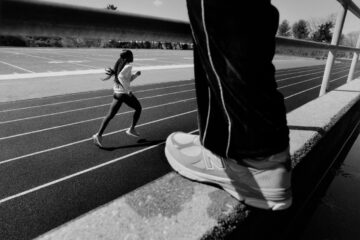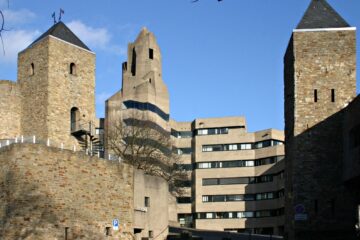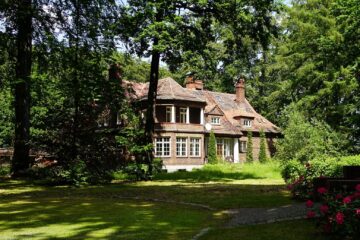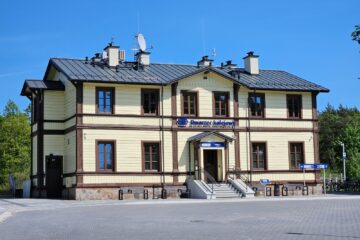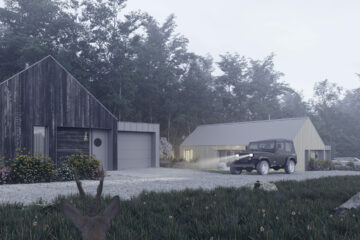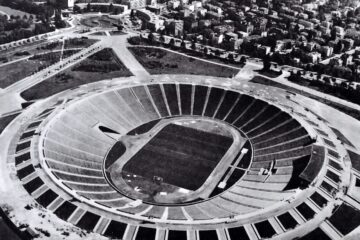The Museum of the Silesian Piasts in Brzeg presents a part of the Functional and Utility Programme of the Borderlands Heritage and Culture Museum related to proposals for the elevation of the future building. The former Piast Gymnasium will be the seat of the new institution. The visualisations, prepared by the Wrocław-based design studio Archistructura, are the result of analyses and research carried out between 2022 and 2023 by Dr. hab. inż. arch. Andrzej Legendziewicz from the Faculty of Architecture at the Wrocław University of Technology, Piotr Wanat, an art conservator – the author of the conservation studies of the building, and Dr Andrzej Peszko from the Museum of the Silesian Piasts in Brzeg
The building of the Piast Gymnasium in Brzeg was erected in 1569 by Prince George II Piast. Its monumental front façade, consisting of four storeys (including an attic) and nineteen window axes, was decorated with nine roof façades, and on the courtyard side with cloisters and a tower. The edifice was intended to resemble a princely palace
It was a Protestant university, which in time became a prominent centre for the education of young noblemen from all over Silesia, Bohemia, Moravia, the Polish-Lithuanian Commonwealth and the German states. For a certain period in the early 17th century, it even gained the privilege of conferring academic titles. It had a valuable library of nearly three thousand volumes, among which were works such as the Lubin Codex (Legend of St Jadwiga), the Chronicle of the Polish Dukes (Chronica principium Poloniae), a printed copy of Martin Luther’s theses against indulgences from 1517, and the famous map of Silesia by Martin Helwig from 1561
Unfortunately, after the extinction of the Piast dynasty in Brzeg in 1675, the institution began to experience problems due to a lack of wealthy patrons. In 1741, it was heavily damaged as a result of Prussian bombardment during the First Silesian War. The building was rebuilt, but it became a regular secondary school. Further reconstructions of the building were carried out in the 19th and 20th centuries. As a direct result of the Second World War, the building was not destroyed, but in May 1945 it burned to the ground after being set on fire by Soviet soldiers. It was rebuilt in the 1960s and housed the Civic Militia Training Centre, and after the system changes, the Police Training Centre. It functioned in this way until 2002, when the facility was closed. Since then, the building became the property of the Municipality of Brzeg and stood empty. In 2021, by virtue of a decision of the Minister of Culture and National Heritage, it was handed over to the Silesian Piasts Museum in order to create a second branch of the institution – the Museum of Heritage and Culture of the Borderlands
Since its establishment, the Piast Gymnasium in Brzeg has gone through various vicissitudes. The building has been the victim of bombings and fires. Each catastrophe resulted in subsequent major reconstructions. Unfortunately, all this led to the destruction of the original Renaissance substance of the building in many places. This has been preserved to the greatest extent in the perimeter walls, part of the cellars, the hallway of the gate passageway, parts of the inner corridors – relics of the cloisters, the former tower integrated into the structure of the building, and the entrance portal itself
The greatest basis for the architectural design of the building was provided by the analysis of relics and iconography of the building from the classicist period – the turn of the 18th and 19th centuries. The results of conservation and architectural research clearly indicate that the building’s façade was then covered with mint-blue plaster. The monumental façade of the building was broken up by three pseudo-horizontals with rustication at ground floor level, and the windows were decorated with frames in the form of earflaps. All these elements are planned to be restored during the restoration work
Remnants of the original colouring were discovered on the entrance portal to the Piast Gymnasium from 1569. It is the intention of the authors of the study to restore it on the basis of the preserved traces. The portal, integrated into the classicist front elevation, will therefore have a distinctly Renaissance character, bearing witness to the original colour solutions of this part of the elevation. A similar treatment was carried out in recent years on the Renaissance portals of the Brest castle (on the city and courtyard sides)

The window frames of the edifice are to be red in colour with divisions into quarters in which smaller panes will be placed. The window frames were formerly not white, as we are accustomed to nowadays. A few hundred years ago, it was usually painted green, even olive green, dark grey or red. Interestingly, windows began to acquire the now common white colour relatively recently – only from the early 19th century
The nine characteristic facades of the roof are said to have gained the colour white. It is known that they originally adorned the building, but were destroyed during a Prussian bombardment in 1741 and did not exist in the late 18th and early 19th centuries. Those that are admired today were restored after the Second World War – in the 1960s. As they did not exist in the Classical era, they are to be given a neutral colour – white
The roof of the Piast Gymnasium itself will be covered with tiles in a darker and lighter shade of red (just like on the Brest castle). This is meant to allude to the old technology, when roof tiles were produced by hand from clay and their colour depended on the degree of firing
In addition to the façade design of the building, the PFU authors also developed solutions for the arrangement and development of the courtyard. The former gymnasium courtyard will be divided into two functional parts. In the first, closer to Wrocław Gate Square, there will be space for the technical provision of the museum facility. In the second part, closer to Chrobrego Street, the area will be developed as an intimate garden with a fountain and glazing at the site of the more interesting archaeological discoveries. Alternatively, the area covered by today’s archaeological works and the relics of the former courtyard infrastructure recorded during them may be covered by a form of pergola running along the fence. The investor will be able to decide on the scope and form of the exposition after analysing the attractiveness of the exposed relics of the buildings
From the side of the courtyard, the rear elevation of the building, which features a staircase wall, will be fully exposed. To break up its monotony, it is intended to decorate it with ivy. A café open to the garden will be located on the ground floor of this part of the Piast Gymnasium
In the structure of the building on the side of the courtyard, it is also planned to expose the remains of the cloisters, which were originally an important part of the decoration of this part of the edifice. Where arcades have been uncovered, glazing two or three storeys high is envisaged
The timetable for the works envisages about three years for the programme of revitalisation and adaptation of the former gymnasium building for museum purposes
text: Andrzej Peszko, Marek Pyzowski
Read also: Metamorphosis | Renovation | Curiosities | History | whiteMAD on Instagram






























